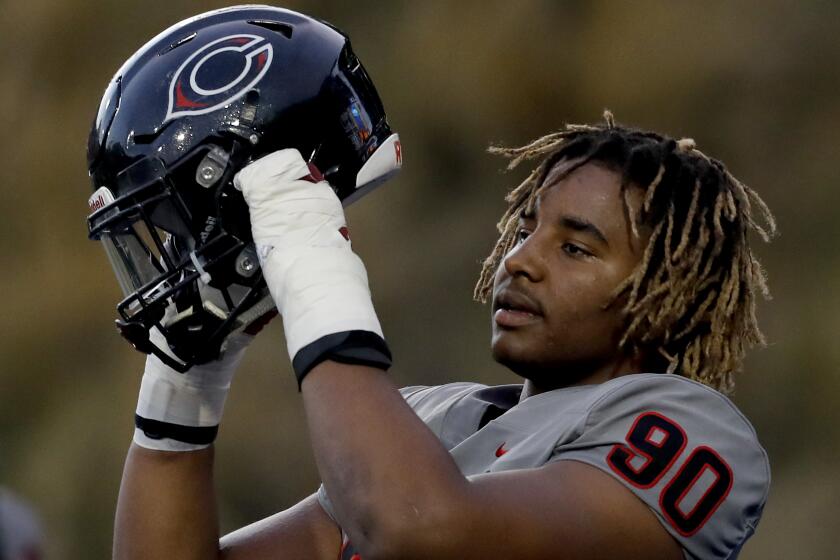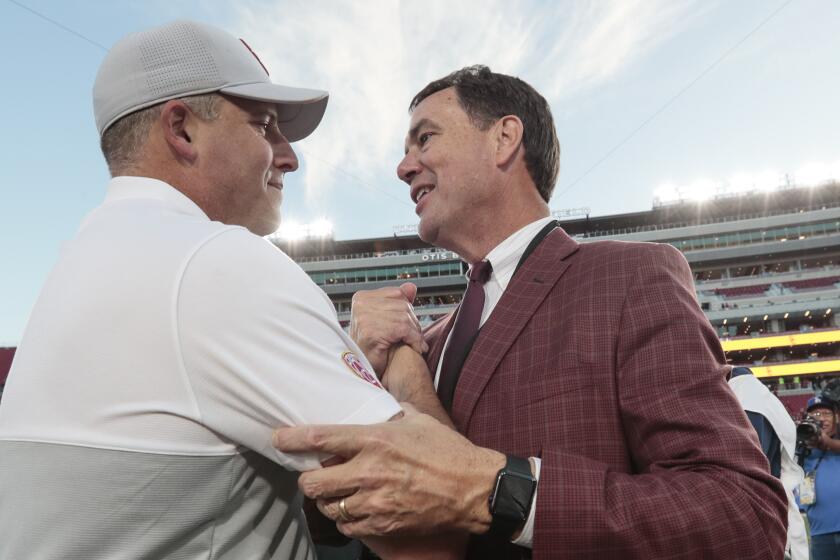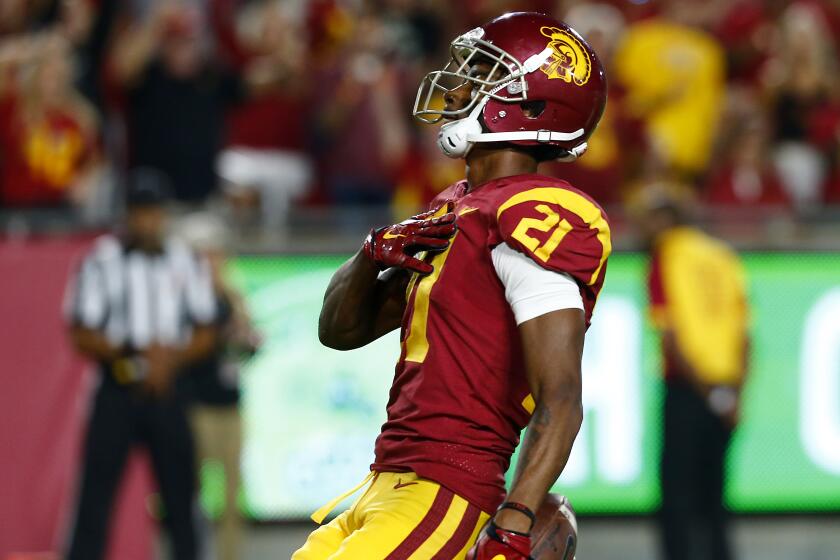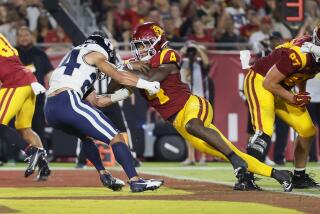Clay Helton upbeat about USC: ‘I actually see this program trending upward’
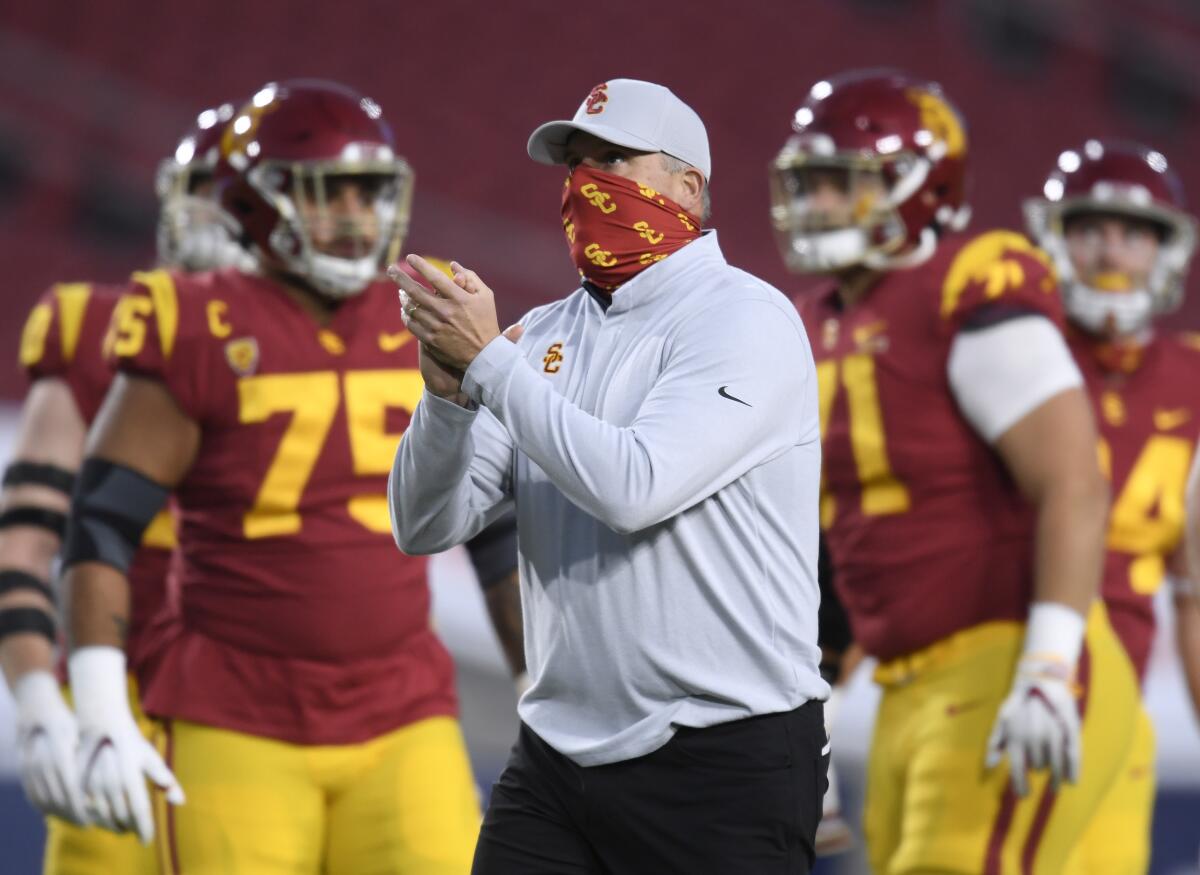
- Share via
Over six tumultuous seasons at the helm of USC football, Clay Helton has grown accustomed to coaching under a cloud of uncertainty. As his Trojans stumbled across the finish line in each of the last three seasons, the head coach’s job security has become a perennial question, his seat perpetually hot for more than half of his tenure.
Helton is used to the constant drumbeat of disillusioned USC fans calling for his firing by now. But no season has ever been defined by uncertainty quite like this last one, as the COVID-19 pandemic upended college football, cut USC’s season to six games and complicated the conversation surrounding the coach.
A shortened season was enough for USC to part ways with its offensive line coach, Tim Drevno, and strength and conditioning coach, Aaron Ausmus, marking a third straight January of upheaval on the Trojans staff. Helton, however, will return in 2021, the embattled coach’s make-or-break campaign extending another year, even as that drumbeat grows louder.
After signing the nation’s No. 1 overall recruit (Corona Centennial’s Korey Foreman) last weekend, Helton spent the last week away from that outside noise, visiting in-laws in Texas and his parents in Florida, neither of whom he’d been able to see throughout the pandemic. By Friday, three weeks out from a devastating Pac-12 title game defeat, Helton was ready to defend the direction of his program in a wide-reaching phone interview with The Times.
USC knew that to sign Corona Centennial’s Korey Foreman, the nation’s No. 1 recruit in football, it needed to make the ultimate sales pitch.
“I see a program that just went to a championship game, that has made some investments in key areas,” Helton said. “I actually see this program trending upward, if you look at it correctly.”
So how exactly should USC evaluate its coach and the progress of its football program after a season played through unprecedented circumstances? The Times asked Helton.
Question: We didn’t hear from you in the wake of the Oregon loss. Obviously that was a pretty painful defeat for the team. Can you explain what happened from that upset locker room, leading up to the decision to decline the bowl invite?
Answer: Really two separate things, to be honest with you. As far as the game goes, we have a standard here. Our standard is championships. For the amount of work and effort that went into getting to that game, to win every game during the regular season, then lose the championship game, our standard is championships. So coming out of that game, nobody was satisfied. As far as myself as the head coach, our staff, our players. That’s USC. That’s the beauty of USC. It’s held to the highest standards and expectations. That’s why you come here. To get all that way in every game, then lose the championship game, obviously leaves a bad taste in your mouth.
As far as the bowl game goes, totally separate situation. When we walked out of that game, we were physically beat up. We walked into the game right above 60 players, and walking out, we were in the mid to low 50s. And in a situation where we had multiple injuries at key positions. Kedon [Slovis] was definitely going to be out with a shoulder injury. Amon-ra [St. Brown], definitely out with a shoulder injury. [Alijah Vera-Tucker], who played like a warrior in that game with a hamstring, was definitely going to be out from that game. Drake Jackson, with a knee. Ralen [Goforth], with a foot. When we walked out of there, we literally were basically one positive test away — or an injury away — from being under that 53 number. So when you looked at the health and safety of our players, as well as what we ask them do as far as a sacrifice, that they could go practice for 10-plus days, give up their Christmas with their families, having been away from their families since July 6, it didn’t seem advantageous to our football team. The bowl game was strictly a health and safety issue.
Q: Was that a decision in which you consulted the players or was that made by coaches and administration?
A: As you saw from our statement, we had a lot of conversations. One was with our leadership group of players. Two was with our medical professionals. Three was with our coaching staff. And also with our administration. Everybody was involved. Obviously tough decisions had to be made before we came into this. Remember, we said the health and safety of our players was No. 1. We all love to compete. We all want to compete. But it won’t be put ahead of where our health is as a football team.
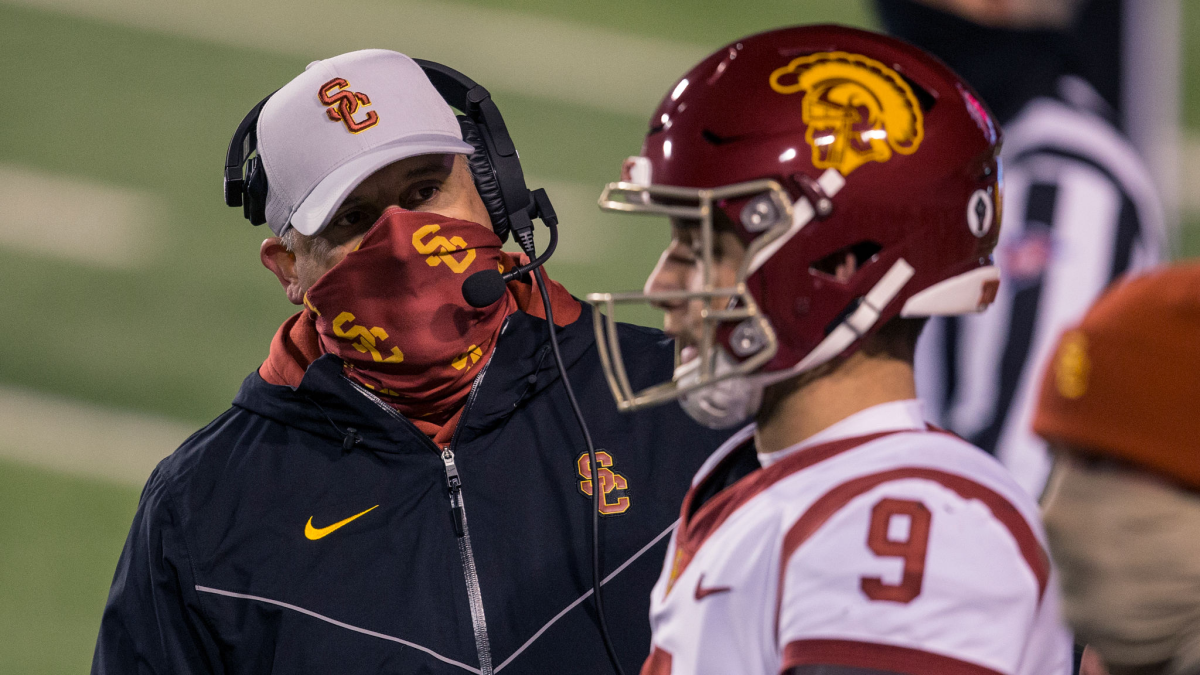
Q: Amid all these challenges, you guys still did finish 5-1. But it took three pretty miraculous comebacks to get to five wins and you did lose in the title game. When you consider all of that together, how do you go about evaluating the season personally? Do you view it as a success?
A: I’ll go back to my original statement. Our standard is championships here. We won every game but one. That one loss happened to be in the championship game. Nobody in the building is satisfied. We want to win championships. We work tirelessly to win championships. When you fall one game short, obviously your soul hurts. The good news is I have a lot of kids who are all pulling in the same direction. I have a staff that’s pulling in the same direction. We were able to get to a championship game. We were able to progress from last year to this year, but at the end of the day, we know we have a little bit more to do to hoist up that trophy. So we go right back to work. We start school Jan. 15. Our kids are coming back in and going through their quarantine protocol, and we’ll start our eight-week, offseason winter workout program. We’ll start spring ball the first of April, and we’ll get right back at progressing as a football team and continuing our culture of toughness and discipline and being united as a team. We made strides this year. But those strides weren’t good enough to win a championship. That’s what we’re judged on, and that’s what we work toward every day.
Q: Some people may not understand how difficult it was to fully carry out this season logistically. How much would you say the uncertainty of everything defined the season as a whole?
A: Some of the best times in your career are some of the more adverse times. I’ve never had more fun with a group of men — players and staff — than what we went through. A group comes together when there’s shared suffering. To be able to walk into that building on July 6 and to accomplish some amazing things from a group of really special men — guys who not only helped our football team, but you’re going to look at how they help themselves individually. I think about the young men who are going to the NFL, what they did for themselves. I think about how young people got to grow this season. Some of our younger players got to grow and have those six games. It was an investment. It was a sacrifice. But at the end of the day, I look back at it and go, ‘Man, what a special memory.’ It’s a team I’ll never forget as long as I live. There was a lot of adversity through the entire year, not only on the football field. That entire year, that was a difficult year for our community. The silver lining for me was to have had a very special moment and memory with a football team that sacrificed so much to play the game they love. It brought us so close together. I got to watch young people as well as vets be able to grow as football players. I think a lot of them put themselves in great positions. I think of a Talanoa [Hufanga], a consensus All-American and getting that opportunity and being able to put that bronze plaque on the wall. I think of an Amon-ra St. Brown and what he’s accomplished, seven touchdowns in three games, that was awesome. There’s story after story of guys that I thought really sacrificed a lot. At the end, we got a lot out of it too.
Q: After [athletic director] Mike Bohn announced that you would be coming back last year, the prevailing assumption was that your future would be evaluated based on this season. Obviously, this was not a normal season by any stretch. How do you feel like those circumstances should be considered in terms of evaluating you as coach or where the program is at?
A: Each and every year, when you’re at a place like USC or elite programs, it could be the NFL, an elite college program, you’re evaluated each and every year. I don’t care if it’s USC or another program. That’s college football. You saw that this year at other places. That’s the nature of college football, you’re evaluated no matter what, each and every year. That’s the nature of the business. It’s welcomed. It’s obviously a standard that you have to live up to consistently, each and every year. We try to live up to that standard each and every year.
Q: You’ve talked a lot about being “on the cusp” and “on the edge” and being just one step away from USC being great again. What do you feel like is holding the program back at this point?
A: I don’t know if that’s necessarily a right comment, to be honest with you. I see a program that just went to a championship game, that has made some investments in key areas. I actually see this program trending upward, if you look at it correctly. You go from an eight-win season, outside of a championship game last year, to now all of a sudden winning every game but one, and you’re in the championship game. I look at recruiting and where we’re going. That’s a huge piece of the puzzle, to be able to sign the best players and bring them in and develop them. I think we’re developing our players the right way. You see the young men that are going out into the NFL, and the guys that have been under us who are thriving in the NFL right now. Players are being developed the right way. This signing class is a huge piece to the puzzle and hopefully a couple more will come along with us in February. But that’s something where I see it trending in the right direction. Yes, we were one game short of a championship. It’s sad. But we’re headed in the right direction, as far as where we want to be and who we’re bringing in to make sure that championships happen on a consistent basis.
While USC’s fans might wonder why Clay Helton isn’t gone yet, Mike Bohn’s decision to keep the beleaguered football coach might be part of a bigger plan.
Q: I think it’s fair to say that the defense took a step forward this year. You allowed 40 yards fewer per game, 3½ fewer points per game. What do you attribute those improvements to?
A: I think you’re only as good as the men that surround you. To be able to have [defensive coordinator] Todd Orlando, [safeties coach] Craig Naivar, [cornerbacks coach] Donte Williams, [defensive line coach] Vic So’oto, I’m very proud of that defensive staff. They walked in here under probably the most adverse conditions possible, not having a spring, and it was, ‘Hey guys, go ahead and you’ve got five weeks and then we’re going to play a game. Good luck.’ But they used the time over the summer with their Zoom meetings to mentally install a defense, and then, I thought, did a wonderful job of not making it too hard on our kids, to not maybe bring the whole Bible in each game, but to make it simple, to allow our kids to play fast. Bringing coach Orlando in and knowing his system, I really thought our personnel fit the system. You never know until you get out there, but it was like, whoa, we were watching guys become playmakers before our eyes. You’re seeing Talanoa Hufanga have a career year. You’re seeing Marlon Tuipulotu, being so disruptive. Drake Jackson is wreaking unbelievable havoc in every way, getting to move him around to different positions. You’re seeing guys that are all of a sudden thrust into a role like Kana’i Mauga. All of a sudden, he’s having double-digit tackles each game. And Ralen, being a first-time starter, getting double-digit tackles a game. I was really hoping at the end of the day that it would be a great personnel fit, and I thought TO and his staff did a wonderful job of two things: Keeping it simple for our kids, and then developing them fundamentally to become even better players than they are. I think really of our corner and safety positions. I’ve watched our corners progress so much under Donte. I’ve watched our safeties progress so much under Craig. I’ve watched our defensive line, how much they’ve improved. To be able to retain each and every one of them and to keep that consistency of the staff, I think it’s huge moving forward.
Q: On the flip side, the run game seemed like it took a step back. You said at the beginning of the season that it would be a “primary focus” for you to be more like an Alabama or an LSU, with a strong passing game, but a run game that could help take pressure off the quarterback. This ended up being the worst rushing team of your tenure. What went wrong in your estimation with the rushing attack?
A: There was a lack of consistency in the production over six games. You look at three of the games and you really, it’s what you want. You look at the Arizona State, Arizona games and even the UCLA game. You’re over 170 yards per game in the Arizona and Arizona State games, and you really feed the ball to Vavae [Malepeai] in the UCLA game, and he has 19 carries for 110-plus yards and all of a sudden, you look up, and you’ve got 40 plus points on the board. I just thought we had a lack of consistency within the run game. There were three games in which it provided the support we needed, and there were three games where the quarterback was asked to do a lot. And one of them, just to be fair, when you play the Washington State game, we never expected anyone to walk in there and play that much man coverage against us. When you see that, I can promise you’re not going to see many carries in a game. It’s going to get thrown a lot. That’s probably a blip on the radar. But for me, I felt like there needed to be better consistency, game in and game out. We really only saw what we truly wanted in three of the games.
Q: Does that require changes in philosophy to the run game moving forward?
A: We’re evaluating right now what we’ll do moving forward. I’m not going to give anything away as we go into that next season. But I think we have — I’ve been around some really good offensive minds, and I’ve been very fortunate to be around an offensive mind like coach [Lane] Kiffin and Coach Sark [Steve Sarkisian], and I’m extremely fortunate to be around an offensive mind like Graham Harrell. For those type of guys, the game is in slow motion for them. They’re the best of the best in what they do. But we will evaluate our run game, make the changes that are necessary to be able to help us, and be able to be more productive.
Q: Speaking of Graham, he talked a lot about how the offense would make a leap in Year 2. In a lot of ways, it didn’t seem on the surface at least that that leap happened. How do you feel about the status of the offense and the Air Raid in general as your system?
A: Again, I don’t know if your question is fair. There’s some areas where it did make improvements. I know from a total yards standpoint, it was slightly down. But when you look at points per game, the production our skill players had, you look at the progression of our quarterback, there were some advances, some nice advances, that were made. At the end of the day, I still think — and we’ve all said this — that there’s more meat on the bone to be had with this offense. I do think this offense can be a 40-point per game offense, rather than in the 30s. We’ll work tirelessly to get it there. We all know that we can do a little bit better in every phase of the game. Not only offensively but defensively and special teams. Each and every year, you don’t get comfortable, you don’t get stagnant. You try to improve in every area and each and every player. That’s what the offseason is for. I believe in what we’re doing. I think we can be more productive in certain areas, and we talked about one in the run game. Those are things that can take you to the next level. But when you look at what this offense can be and what it can do, I believe in this offense. I believe in Graham Harrell and what he’s about and how talented he is at what he does. We’ll continue to make the improvements needed to be the best offense in the country.
Q: You parted ways with Tim Drevno and Aaron Ausmus after the season. Why was it the offensive line coach and strength and conditioning coaches who were specifically held accountable?
A: I’ll go back to the statement I released earlier. After just careful evaluation, we decided to go in a different direction. I’m thankful to both men on how much support they gave our student athletes and our football players. We’re working to fill both spots as we speak. I’ll leave it at that.
Q: Where do you feel like the offensive line stands right now?
A: Personnel-wise, I think we’re in a good position. You look at it, you’re really losing, as of right now, just one member of that offensive line in Alijah Vera-Tucker, who I think is going to be a top draft pick, a first-round draft pick in the NFL. He was as productive this year as Austin [Jackson] was the previous year. I think we’ve gotten the opportunity to have back-to-back first-round draft picks on the offensive line, and when you look across the board, you have the availability of an Andrew Vorhees back, a Brett Neilon back, a Liam Jimmons back, a Jalen McKenzie back, plus the continued progression of some younger players, like a Justin Dedich or the freshmen working the entire year, a Jonah Monheim, a Courtland Ford, and a Casey Collier. When I look at that offensive line, you look not just at what pieces you got coming back, but the additional pieces that signed with us in December. You have three very nice pieces that just came in. I really like the veteran leadership that’s on that offensive line, as well as the talent of our younger players. I think we’re in a very good position moving forward with some guys that have played a lot of football. Just losing one key piece of the puzzle, and it’ll be very important to find the next left tackle as we move into the spring and the fall, but when you look at the list of what’s coming back on that offensive line, you feel pretty darn good.
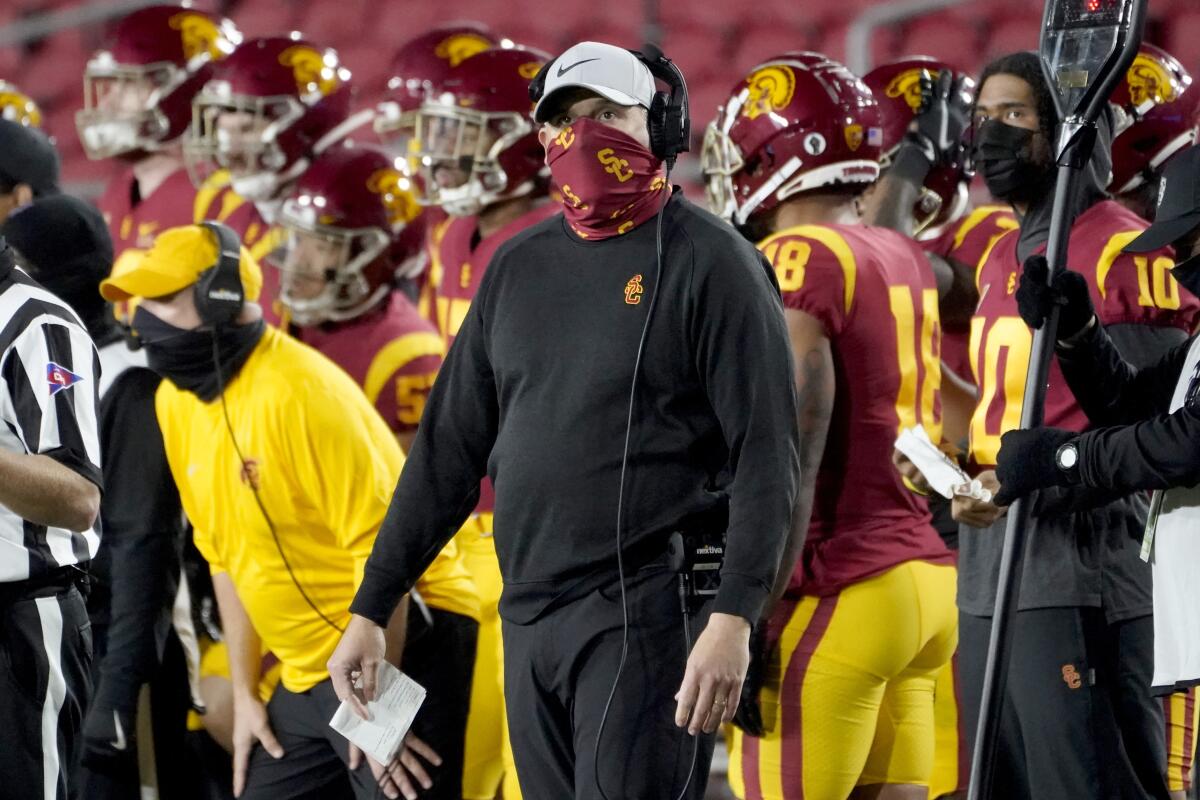
Q: In the case of the decision with [Drevno], was that more based on him being the run game coordinator and the step back that that group took?
A: Again, I’m not going to get into that. But I appreciate you.
Q: Last year, you parted ways with five assistants and changed the defensive staff. The year before that, you let go of four and changed the offense. At what point does that accountability fall to you as the head coach?
A: As you go into each and every year, you evaluate what needs to be done to help advance your program and changes are made to help take the next step. We made some changes last year that I think truly helped advance our football team. It showed on the field. That’s a hard part of the job, as the leader is identifying how you feel you can get better and make those changes. For us, we made some changes last year that I think everybody would agree benefited our football team. With the system that TO brought in, from how it fit our personnel, I think it helped our football team. That happens at every level. You evaluate each and every year, and if you feel like there can be advances made for your football team, changes are made.
Q: Do you feel like you’ll be coaching for your job next season?
A: I’ll say this to you, each and every year, whether you’re on an NFL football team or at one of those premier college programs, you’re evaluated every year. Every year. You’ve seen that across college football. That’s the beauty of our game. Each and every year, there’s a standard. You fight as hard as you can to meet that standard, and you’re evaluated each and every year. Every college coach at one of those programs is. It’s not just myself. It’s everyone across the profession. It’s something that each and everyone, head coaches and coordinators and position coaches at premier programs, you’re evaluated each and every year.
Q: You’ve talked about how many players are on their way to the NFL. You’ve lost two of your top three receivers, your top offensive lineman, your top defensive lineman, your No. 1 corner. That’s a lot to overcome moving forward. What gives you confidence that you can make up for those departures?
A: Think about it real fast. I feel pretty confident in [cornerback Isaac Taylor-Stuart], don’t you? One of the things you do as a head coach and as a staff and as a personnel manager, which I think Spencer Harris does an amazing job for us, is making sure you have adequate depth, so when you do lose premier players that are making good decisions for themselves and their families, that you have guys that all of a sudden you look up, and you have [cornerback] Chris Steele coming in his third year, but you also have a guy like ITS, who’s giving us about 15 to 20 reps per game, and really made his plays. We had no lack of production. Now all of a sudden, he gets his time to be in that position and keep moving forward. All of a sudden you lose a Tyler Vaughns and an Amon-ra St. Brown, but you look up and go, what type of progression did Drake London have this year? How did a Bru McCoy develop and was ready to step onto the scene? We saw some really nice flashes of Gary Bryant as a true freshman with very limited time and training. You look at being able to have some guys at the running back position and tight end position that are all coming back. And most importantly, you have a trigger man who, in my opinion, is pretty darn special. Part of building a roster is you understand that you’re going to lose some really talented players. But it also allows the guys that are sitting there right on the cusp and waiting, who have been training and waiting for their opportunity, now it’s here. We’re thankful to have that depth to be able to look up and say, now that opportunity is coming.
USC wide receiver Tyler Vaughns announced on social media Monday that he will forego his last season of eligibility to enter the 2021 NFL draft.
Q: With [running backs] Markese [Stepp] entering the transfer portal and Vavae and Stephen [Carr] both seniors, is there a lot of uncertainty at that position going into the season? Are you hopeful that Vavae and Stephen would give it another go?
A: I look at that position, and I think it was very strong coming into the year. I feel like it’ll be very strong going into next season. Obviously each man has a decision to make. The door has been left open for Markese. Vavae and Stephen have given no hint of not coming back, and Kenan Christon is still here, as well as Brandon Campbell, who’s just arriving on campus. I look at that position, and it’s still strong with depth.
Q: Does it feel like you can plan for a normal spring? Is there any shred of normalcy that you can count on for this offseason?
A: A couple things are kind of moving back this spring. It’s for a couple reasons. Usually as you know, we start spring in early March. But with the nature of what our kids just went through for six months, playing a little bit later in the season, playing multiple games in December, which usually doesn’t happen, and having our kids from out of the Southern California area having to report back to campus and go through a 10-day quarantine and wanting to be able to have a true eight-week cycle of winter workouts and strength and conditioning to prepare their bodies correctly for training camp and keeping them healthy and safe, we are going to push back our spring football. We know how important it is for us. You’re looking at an early April start, rather than early March. We’re pushing it back, and we hope that from a community standpoint, maybe things will start trending in the right direction.
More to Read
Go beyond the scoreboard
Get the latest on L.A.'s teams in the daily Sports Report newsletter.
You may occasionally receive promotional content from the Los Angeles Times.

